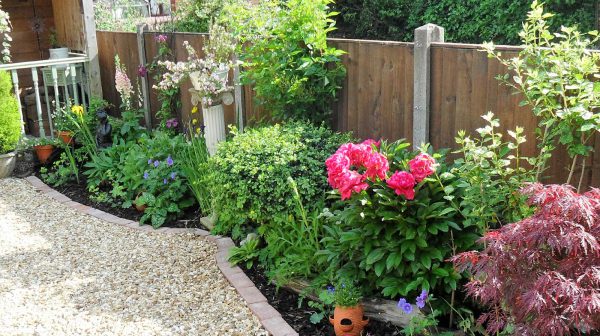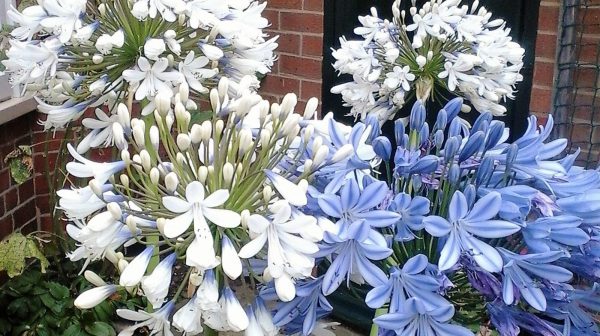Latest News
Working in a COVID safe way 2021
03/03/2021
May Reminders
27/04/2017
Feed Your Plants!
Late April into May is the perfect time to boost your plants, trees and shrubs by adding fertiliser (feed). They will benefit by becoming strong and healthy, especially the faster growing plants as they use lots of energy to perform. The list of fertilisers is large and can be overwhelming, if you are unsure which to use ask at the garden centre. Basically plants require 3 basic nutrients; potassium (or potash as it is also known) for flower or fruit production, nitrogen for the foliage and phosphorous for healthy root growth. Once you know which sort of growth you wish to encourage, there are 2 types of feed available – liquid feed which requires diluting before applying and compound (solid) feed. Solid feed lasts longer as it breaks down gradually and liquid feed is absorbed by the plant more quickly providing an instant nutrient boost but will require applying more regularly.
Growmore is a good general solid fertiliser with a good balance of all 3 basic nutrients and is ideal for the whole garden; trees, flowers, shrubs, vegetables and borders and you just scatter it around where required. Liquid fertilisers are ideal for your tubs, containers, hanging baskets, tomato and chilli plants as such plants require lots of energy to provide the beautiful flowers/fruits. Acid loving plants such as camellias, azaleas, magnolias, rhododendrons and heathers will benefit from an application of liquid ericaceous plant feed as well as a few centimetres of ericaceous compost placed around the base of the plant.
When applying liquid feed, do not let it touch the leaves as it can scorch the leaves.
There are also slow release fertilisers available – the variety of all types of feed is huge, so just ask or check on the internet if you are unsure. Even if you just scatter a little Growmore around the garden, it will have a positive impact on the garden!
Spring Pruning
Spring is the time to prune many plants as it encourages more foliage, flowers and colourful stems as air flow improves allowing the new growth to ‘breathe’. Also by removing crossing stems, you will avoid injury to stems which often results in infections/diseases getting into the damaged stem. Pruning in Spring removes old, dead, diseased or weak stems and results in a more pleasing shape for the plant. It is important to add a generous amount of mulch once you have finished pruning the plant. It gives the plant a boost and can be a general compost or well rotted manure. Amongst others here are a few plants which will definitely benefit from Spring pruning:
Summer Flowering Shrubs – such as buddleja and fuchsia. These have flowered last Summer and will benefit from hard pruning in Spring as it encourages lots of new growth and flowers for this Summer. These plants produce flowers on new growth so if they are not pruned back now the plant will become very leggy with flowers mainly at the top of the plant which isn’t attractive. Prune at the second to last pair of new leaves, not to the last because if there is a harsh frost the plant will have lost its new growth bud.
Tender Shrubs – such as lavender and rosemary. Over Winter, such Mediterranean shrubs need protection from their old, top growth but in the Spring this can be removed to encourage lots of healthy new growth.
Deciduous Grasses – these can be cut back hard in the Spring. Use a pair of shears and cut back, right down the base of the plant. For evergreen grasses do not use shears or you will ruin the plant! Gently tease out the old, brown growth with your fingers or use a specific comb hand tool which gently rakes through and removes the dead growth.
April Reminders
12/04/2017
Water Pots
During Winter pots of bulbs can be left alone but as soon as new growth appears keep them well watered as April showers will not do the job thoroughly enough! The leaves prevent water reaching the roots – you can also provide an extra boost by using a liquid or slow release fertiliser.
Plant Summer Flowering Bulbs
Alliums, oriental lilies, freesia, gladioli & irises to name a few summer flowering bulbs can be planted now as they do may not survive in the ground if the Winter is wet or particularly cold. Free draining soil and plenty of sunshine is usual for these plants but do check the instructions for preferred conditions. Ideally add a layer of grit to the soil after planting to protect the shoots from slugs and snails.
Deadhead Daffodils
If your daffodils have gone over, dead head them with either scissors or pinch just below the round part beneath the faded flower stems with your finger and thumb and leave the foliage to die down naturally. Its tempting to cut foliage back as it looks untidy but leaving it alone allows all the goodness to go back into the bulb which strengthens the plant for a better show next year.
Feed/Spray
Most plants whether flowering or evergreen will benefit from regular feeding now. Check instructions for amounts and regularity. Roses love manure/organic material but if using manure avoid placing in contact with new growth as it can burn. Buxus (box) benefits from a specific liquid feed available from garden centres and for borders and pots try a general fertiliser. Basic liquid tomato feed or seaweed based feed is ideal. Spray roses to control attacks from aphids and blackspot disease.
Prepare for Slugs and Snails
The bane of every gardener’s life! They love to demolish tender new growth, especially at night when the soil is damp. Control methods include pellets (please use pet friendly!), barriers, nematodes, traps and barriers. Some people sink small containers in the soil with beer or milk which attract the pests, others use copper wire around rims of pots, sharp grit or eggshells around vulnerable plants & others physically remove the pests from plants in the evenings and early mornings.
March Reminders
20/03/2017
Plant Shrubs Now
March is the ideal time to plant woody shrubs because the roots have chance to grow before new foliage places stress on the plant. Before planting, weed thoroughly the area for the new shrub then dig a wide, shallow hole the same depth as the height of the rootball and loosen the subsoil. Water the shrub in well and cover the surrounding soil with garden compost.
Prune for New Growth
Early March is the perfect time to prune climbing plants & shrubs which flower on new stems, for example buddleia, late flowering clematis and roses. Do not be tempted to do this too early (February if new shoots are evident) as any resulting new growth could be damaged by frost. Cut back to above a leaf bud or sideshoot. The reason its good to prune now is to promote fresh, vigorous new growth so climbers such as clematis (Viticella Group) will provide numerous flowers and also solve the problem of flowers appearing high up but bare lower stems. Shrubs can also be cut back quite hard to provide large leaves during the summer or colourful bark next winter.
Deadhead Early Flowering Spring Bulbs
As soon as your spring bulbs have faded, its important to deadhead them. Why? Deadheading stops them setting seed as if this happens energy goes to setting the seeds instead of feeding the bulb ready for producing flowers the following spring. Snip off or pinch out the faded flower with the slight swelling behind it from the top of the stalk. Leave the foliage and green stalk in place as this means the plant to produce its own sugar which hep to feed the bulb even more. Let the foliage die down naturally.
Cut Back Hardy Perennials
Before the spring growth gets started remove any dead stems from clumps of perennials. Pull them out or snip at ground level.
Lift & Divide Snowdrops
This is the perfect time to divide clumps of snowdrops while the flowers are fading but the plant is still growing (known as ‘in the green’) It’s worth doing as snowdrops are notoriously tricky to grow from bulbs and this will spread them around your garden and produce more healthy plants. Dig up a clump, taking care not to decapitate the plant as the bulbs can be quite deep. Soak the clump in water then gently prise it apart and plant in smaller groups roughly 10cm apart at the original depth.
Mulch Your Flower Beds & Borders
Mulching is a great way to hold moisture into the soil and help to keep weeds to a minimum. If you do this now before the new spring growth gets under way you will have easier access throughout the border to get to your plants without damaging them. Mulches include compost, bark chippings, leaf mould amongst other organic alternatives. Take care not to cover developing foliage/buds.

New website launched
19/10/2016
After much hard work and preparation we are delighted to launch our brand new website.
Welcome world to: www.landgirlgardener.co.uk
You can see all our latest news and Seasonal tips to get the most out of your garden.
Stay in touch and let us know if you have any projects we can help you with.
Best Regards
Jo Tyler – Proprietor
Landgirl Gardener

October Reminders
19/10/2016
FLOWERS
Continue to plant spring – flowering herbaceous perennials and bulbs; October is the best time to plant daffodils; November for tulips. When buying bulbs, reject any that show signs of mould or are soft. Small bulbs may not flower in the first year so opt for large, fat, firm bulbs.
Prepare the ground by weeding and incorporate compost and in heavy soil, dig in grit for drainage. If you are planting bulbs in pots, drainage is essential so put in lots of crocks at the bottom and use a well draining compost. Bulbs need to be planted 3 to 4 times as deep as the bulb itself, so say you have a crocus bulb of 1 inch, plant it 3 – 4 inches deep. In mild areas, continue to sow hardy annuals outside as they will over-winter nicely to provide a stunning display next year.
Collect any seed heads and store the seeds somewhere dry (labelled envelopes are ideal) for future use.
Place all tender plants into a heated greenhouse to keep safe over the winter.
Remove stakes/supports as herbaceous plants begin to die back.
TREES & SHRUBS
Collect fallen leaves and add to your compost heap as they add to make excellent compost! Leaf mould is also an excellent mulch/compost/nutrient rich addition for the garden. Simply fill empty compost bags, chop up the leaves, add water initially then just fold down the top of the bag, store in the garden and wait. Next Spring/Summer you will have wonderful, rich leaf mould…and its free! Plant new bushes and trees as the soil is moist and still relatively warm.
FRUIT
By the end of October, plant any remaining fruit trees and bushes as they will have time to establish over the winter.
VEGETABLES
Store beetroot for the winter. Lift them, twist off the tops and store in the garden under a layer of straw and soil. Put cloches over early carrots and spring cabbages. Clear away any remaining pea stems. Cut any remaining pumpkins, squashes and marrows and store in a dry, frost free place such as the shed and they should keep until the end of the year.
PONDS
Water hyacinths and other tender pond plants need any drying foliage to be removed. Place the plants in trays of damp sand or deep mud and put them in the greenhouse or shed until any risk of frost has passed (spring). Place netting over the pond to prevent leaves falling in and polluting the water. If the water looks brown or dark green, drain half of the water away and refill with fresh water.
LAWNS
October is an ideal time to set a new lawn as the grass seeds can take root before growth completely stops in winter. Its advisable to prepare the ground well by weeding, raking and levelling the area before scattering the seeds sparingly. Cover with fleece to protect the area until germination has taken place. Netting is also a good idea to prevent the birds from eating the seeds.
